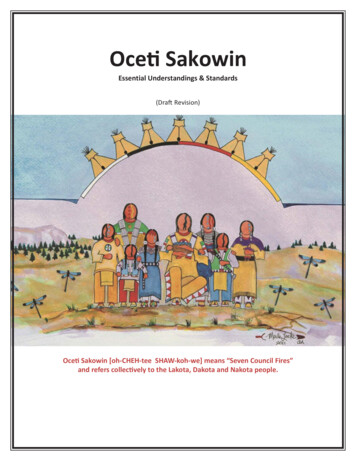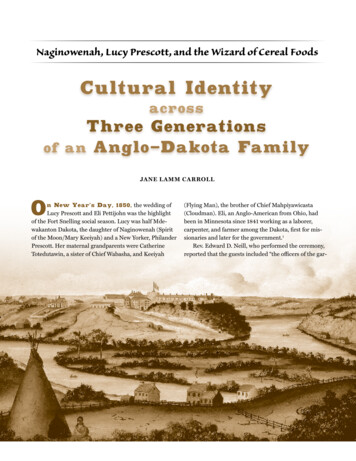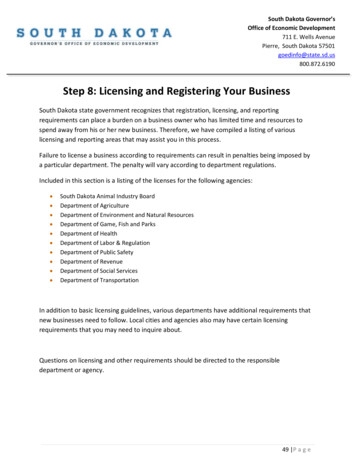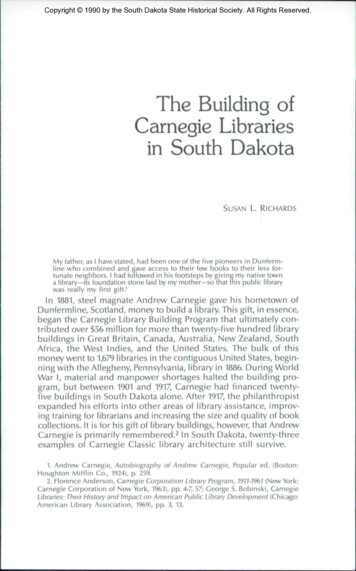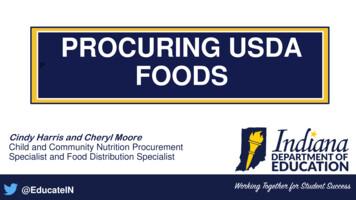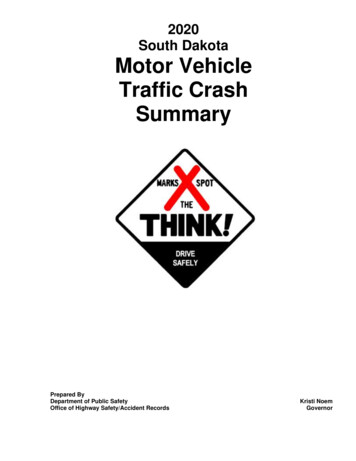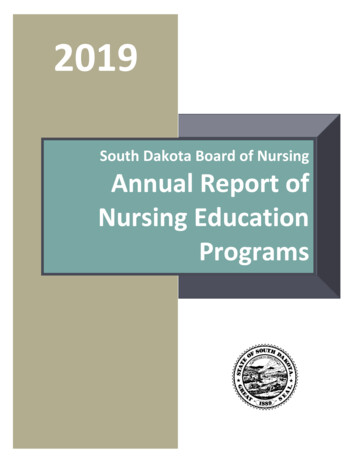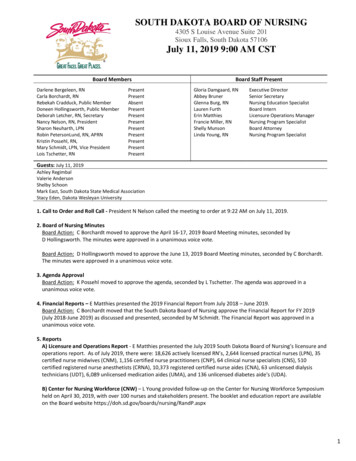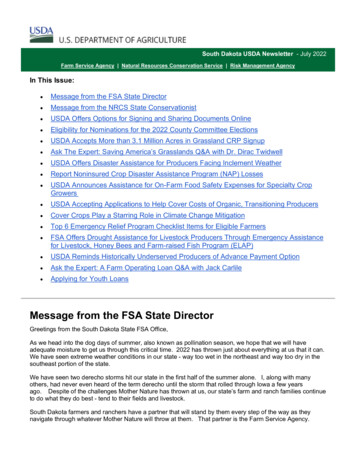
Transcription
South Dakota USDA Newsletter - July 2022Farm Service Agency Natural Resources Conservation Service Risk Management AgencyIn This Issue: Message from the FSA State Director Message from the NRCS State Conservationist USDA Offers Options for Signing and Sharing Documents Online Eligibility for Nominations for the 2022 County Committee Elections USDA Accepts More than 3.1 Million Acres in Grassland CRP Signup Ask The Expert: Saving America’s Grasslands Q&A with Dr. Dirac Twidwell USDA Offers Disaster Assistance for Producers Facing Inclement Weather Report Noninsured Crop Disaster Assistance Program (NAP) Losses USDA Announces Assistance for On-Farm Food Safety Expenses for Specialty CropGrowers USDA Accepting Applications to Help Cover Costs of Organic, Transitioning Producers Cover Crops Play a Starring Role in Climate Change Mitigation Top 6 Emergency Relief Program Checklist Items for Eligible Farmers FSA Offers Drought Assistance for Livestock Producers Through Emergency Assistancefor Livestock, Honey Bees and Farm-raised Fish Program (ELAP) USDA Reminds Historically Underserved Producers of Advance Payment Option Ask the Expert: A Farm Operating Loan Q&A with Jack Carlile Applying for Youth LoansMessage from the FSA State DirectorGreetings from the South Dakota State FSA Office,As we head into the dog days of summer, also known as pollination season, we hope that we will haveadequate moisture to get us through this critical time. 2022 has thrown just about everything at us that it can.We have seen extreme weather conditions in our state - way too wet in the northeast and way too dry in thesoutheast portion of the state.We have seen two derecho storms hit our state in the first half of the summer alone. I, along with manyothers, had never even heard of the term derecho until the storm that rolled through Iowa a few yearsago. Despite of the challenges Mother Nature has thrown at us, our state’s farm and ranch families continueto do what they do best - tend to their fields and livestock.South Dakota farmers and ranchers have a partner that will stand by them every step of the way as theynavigate through whatever Mother Nature will throw at them. That partner is the Farm Service Agency.
FSA cannot control the weather; however, it can be there to help farmers and ranchers get through theweather challenges.The Emergency Conservation Program (ECP) can be utilized to get fresh water to livestock when dams dryup. ECP can also be tapped into to help farm and ranch families with debris cleanup to get their fields backinto production.This past month farmers and ranchers with 2020 or 2021 disaster losses are eligible for help through theEmergency Relief Program (ERP). The program was the result of legislation passed by Congress and signedinto law by President Biden on September 30, 2021. So far, the ERP program has supported South Dakotafarm and ranch families with over 475 million in assistance.Many folks outside of agriculture might wonder why do farm and ranch families need this kind of assistancewhen crop and livestock prices are strong?The point to remember is a disaster loss occurred. Many farmers didn’t have the opportunity to capture 8corn or 16 soybeans because they had a crop disaster. Livestock producers had to haul water when damsdried up or had to haul hay in or haul cattle to greener pastures in other parts of the state.These natural disasters came on the heels of skyrocketing fertilizer prices and then compounded by the warin Ukraine, so the timing of the ERP could not have come at a better time!As always, if you are for looking for more information on the services FSA can provide, please contact yourlocal USDA Service Center or reach me at steve.dick@usda.gov.Sincerely,Steve DickState Executive DirectorUSDA - Farm Service AgencyMessage from the NRCS State ConservationistGreetings and I hope you had an enjoyable and safe Fourth of July celebration,Small grain harvest is underway in South Dakota and I want to encourage the planting of cover crops onthose acres being harvested now. Over 400,000 acres of cover crop were planted in South Dakota lastsummer as indicated by Farm Service Agency records (NRCS Focus on Soil Health page 6). Cover Crops area significant component to four of the five principles in building healthy soils on cropland. They armor the soil,increase the diversity of plant roots thereby diversifying microbial life, extend the length of time a growing rootis feeding the soil microbes, and allow the integration of livestock into the natural soil building process. Pleasecontact the NRCS at your local USDA Service Center and visit Resources for Cover Crops in SouthDakota for more information about cover crops.In celebration of National Bison month, I’d like to promote one of the South Dakota producers we work closelywith and encourage you to watch her story raising bison on their operation and integrating soil healthprinciples on grasslands.Finally, I want to congratulate the Bien Family Ranch of Veblen, SD as the recipient of this year's LeopoldConservation Award and I hope to see you at their August 9 tour.Thank you to all South Dakota farmers, ranchers, and landowners moving the needle of conservation in ourstate.Sincerely,
Tony SunseriState ConservationistUSDA-Natural Resources Conservation ServiceUSDA Offers Options for Signing and Sharing DocumentsOnlineFarmers and ranchers working with USDA’s Farm Service Agency or Natural Resources ConservationService can now sign and share documents online in just a few clicks. By using Box or OneSpan, producerscan digitally complete business transactions without leaving their homes or agricultural operations. Bothservices are free, secure, and available for multiple FSA and NRCS programs.Box is a secure, cloud-based site where FSA or NRCS documents can be managed and shared. Producerswho choose to use Box can create a username and password to access their secure Box account, wheredocuments can be downloaded, printed, manually signed, scanned, uploaded, and shared digitally withService Center staff. This service is available to any FSA or NRCS customer with access to a mobile deviceor computer with printer connectivity.OneSpan is a secure eSignature solution for FSA and NRCS customers. Like Box, no software downloads oreAuthentication is required for OneSpan. Instead, producers interested in eSignature through OneSpan canconfirm their identity through two-factor authentication using a verification code sent to their mobile device ora personalized question and answer. Once identity is confirmed, documents can be reviewed and e-signedthrough OneSpan via the producer’s personal email address. Signed documents immediately becomeavailable to the appropriate Service Center staff.Box and OneSpan are both optional services for customers interested in improved efficiency in signing andsharing documents with USDA, and they do not replace existing systems using eAuthentication for digitalsignature. Instead, these tools provide additional digital options for producers to use when conductingbusiness with FSA or NRCS.USDA Service Center staff are available to help producers get started with Box and OneSpan through a fewsimple steps. Please visit farmers.gov/service-locator to find your local office and let Service Center staffknow you’re interested in signing and sharing documents through these new features. In most cases, onequick phone call will be all that is needed to initiate the process.Visit farmers.gov/mydocs to learn more about Box and OneSpan, steps for getting started, and additionalresources for conducting business with USDA online.To learn more about program flexibilities and Service Center status during the coronavirus pandemic,visit farmers.gov/coronavirus.Eligibility for Nominations for the 2022 County CommitteeElectionsThe U.S. Department of Agriculture (USDA) Farm Service Agency (FSA) county committees are a criticalcomponent of the day-to-day operations of FSA and allow grassroots input and local administration of federalfarm programs.Committees are comprised of locally elected agricultural producers responsible for the fair and equitableadministration of FSA farm programs in their counties. Committee members are accountable to the Secretary
of Agriculture. If elected, members become part of a local decision making and farm program deliveryprocess.A county committee is composed of three to 11 elected members from local administrative areas (LAA). Eachmember serves a three-year term. To be eligible for nomination and hold office as a committee member oralternate, a person must fulfill each of the following requirements: (1) be a producer with an interest in farmingor ranching operations, (2) participate or cooperate in any FSA program provided for by law, (3) be a U.S.citizen, (4) be of legal voting age, (5) meet the basic eligibility requirements, and (6) reside in the county ormulti-county jurisdiction in which they will be serving. A cooperating producer is someone who has providedinformation about their farming or ranching operation(s) but may not have applied or received FSA programbenefits.All nomination forms for the 2022 election must be postmarked or received in the local USDA Service Centerby Aug. 1, 2022. For more information on FSA county committee elections and appointments, refer to theFSA fact sheet: Eligibility to Vote and Hold Office as a COC Member available onlineat: fsa.usda.gov/elections.USDA Accepts More than 3.1 Million Acres in GrasslandCRP SignupThe U.S. Department of Agriculture (USDA) is accepting offers for more than 3.1 million acres fromagricultural producers and private landowners through this year’s Conservation Reserve Program (CRP)Grassland Signup, the highest in history. The signup’s results include 424,984 acres in South Dakota. Thisprogram allows producers and landowners to continue grazing and haying practices while protectinggrasslands and promoting plant and animal biodiversity and conservation, and it’s part of the Biden-Harrisadministration’s broader effort to address climate change and to conserve natural resources.Nationwide, this year’s Grassland CRP signup surpassed last year’s 2.5 million acres by 22%. So far thisyear, producers have enrolled 2 million acres through the General Signup and more than 464,000 acres havebeen submitted through the Continuous CRP Signup. This means about 5.6 million acres are entering CRP in2023, surpassing the 3.9 million acres expiring this year.Other highlights include: Top states included Colorado (642,000 acres), South Dakota (nearly 425,000 acres) and Nebraska(nearly 422,000 acres). States with the highest increase in acres compared with last year include Arizona (141% increase),California (129% increase), and Utah (122% increase).Because Grassland CRP supports not only grazing operations but also biodiversity and conservingenvironmentally sensitive land such as that prone to wind erosion, USDA’s Farm Service Agency (FSA)created two National Priority Zones in 2021: the Greater Yellowstone Migration Corridor and Dust Bowl Zone.For this year’s signup, FSA expanded the Greater Yellowstone Wildlife Migration Corridor Priority Zone toinclude seven additional counties across Montana, Wyoming, and Utah, to help protect the big-game animalmigration corridor associated with Wyoming elk, mule deer and antelope. FSA accepted offers on more than1.4 million acres in these two zones.Grasslands enrolled in CRP help sequester carbon in vegetation and soil, while enhancing resilience todrought and wildfire. Meanwhile, producers can still conduct common grazing practices, such as haying,mowing, or harvesting seed from the enrolled land, which supports ag production.Broadening Reach of ProgramAs part of the Agency’s Justice40 efforts, producers and landowners whoare historically underserved, including beginning farmers and military veterans, will receive 10 additionalranking points to enhance their offers. From more than 5,000 underserved producers, USDA accepted offers
of more than 1.9 million acres, about 87% of those who submitted applications.Additionally, USDA isworking to broaden the scope and reach of Grassland CRP by leveraging the Conservation ReserveEnhancement Program (CREP) to engage historically underserved communities. CREP is a partnershipprogram that enables states, Tribal governments, and non-profit entities to partner with FSA to implementCRP practices and address high priority conservation and environmental objectives. Interested entities areencouraged to contact FSA.Producers can still make an offer to participate in CRP through the Continuous CRP Signup, which isongoing, by contacting the FSA at their local USDA Service Center.Ask The Expert: Saving America’s Grasslands Q&A with Dr.Dirac TwidwellIn this Ask the Expert, Dr. Dirac Twidwell, Natural Resources Conservation Service (NRCS) Working Landsfor Wildlife (WLFW) Science Advisor and Associate Professor at the University of Nebraska outlines howlandowners can work together to protect and conserve grasslands through conservation. Dr. Twidwell isresponsible for conserving grasslands on the Great Plains through science-backed efforts that spanownership boundaries. His research and publications have identified the largest remaining continuousgrasslands in the United States and have outlined a ‘call to action’ to protect and preserve these invaluablebiomes.He also runs the Large-Scale Rangeland Conservation Lab at the University of Nebraska-Lincoln, whichfocuses on providing a framework for ecosystem management across multiple states. Dr. Twidwell recentlyco-authored Reducing Woody Encroachment in Grasslands: A Guide for Understanding Risk andVulnerability that provides the first-ever framework for addressing woody encroachment in the Great Plains.To read the full blog visit ands-qa-with-dr-dirac-twidwell.USDA Offers Disaster Assistance for Producers FacingInclement WeatherSevere weather events create significant challenges and often result in catastrophic loss for agriculturalproducers. Despite every attempt to mitigate risk, your operation may suffer losses. USDA offers severalprograms to help with recovery.Risk ManagementFor producers who have risk protection through Federal Crop Insurance or the Noninsured Crop DisasterAssistance Program (NAP), we want to remind you to report crop damage to your crop insurance agent or thelocal Farm Service Agency (FSA) office.If you have crop insurance, contact your agency within 72 hours of discovering damage and be sure to followup in writing within 15 days. If you have NAP coverage, file a Notice of Loss (also called Form CCC-576)within 15 days of loss becoming apparent, except for hand-harvested crops, which should be reported within72 hours.Disaster AssistanceUSDA also offers disaster assistance programs, which is especially important to livestock, fruit and vegetable,specialty and perennial crop producers who have fewer risk management options.
First, the Livestock Indemnity Program (LIP) and Emergency Assistance for Livestock, Honeybee and Farmraised Fish Program (ELAP) reimburses producers for a portion of the value of livestock, poultry and otheranimals that died as a result of a qualifying natural disaster event or for loss of grazing acres, feed andforage. And, the Livestock Forage Disaster Program (LFP) provides assistance to producers of grazed foragecrop acres that have suffered crop loss due to a qualifying drought. Livestock producers suffering the impactsof drought can also request Emergency Haying and Grazing on Conservation Reserve Program (CRP) acres.Next, the Tree Assistance Program (TAP) provides cost share assistance to rehabilitate and replant tree,vines or shrubs loss experienced by orchards and nurseries. This complements NAP or crop insurancecoverage, which cover the crop but not the plants or trees in all cases.For LIP and ELAP, you will need to file a Notice of Loss for livestock and grazing or feed losses within 30days and honeybee losses within 15 days. For TAP, you will need to file a program application within 90 days.DocumentationIt’s critical to keep accurate records to document all losses following this devastating cold weather event.Livestock producers are advised to document beginning livestock numbers by taking time and date-stampedvideo or pictures prior to after the loss.Other common documentation options include: Purchase records Production records Vaccination records Bank or other loan documents Third-party certificationOther ProgramsThe Emergency Conservation Program and Emergency Forest Restoration Program can assist landownersand forest stewards with financial and technical assistance to restore damaged farmland or forests.Additionally, FSA offers a variety of loans available including emergency loans that are triggered by disasterdeclarations and operating loans that can assist producers with credit needs. You can use these loans toreplace essential property, purchase inputs like livestock, equipment, feed and seed, or refinance farmrelated debts, and other needs.Meanwhile, USDA’s Natural Resources Conservation Service (NRCS) provides financial resources throughits Environmental Quality Incentives Program to help with immediate needs and long-term support to helprecover from natural disasters and conserve water resources. Assistance may also be available foremergency animal mortality disposal from natural disasters and other causes.Additional ResourcesAdditional details – including payment calculations – can be found on our NAP, ELAP, LIP, and TAP factsheets. On farmers.gov, the Disaster Assistance Discovery Tool, Disaster-at-a-Glance fact sheet, and FarmLoan Discovery Tool can help you determine program or loan options.While we never want to have to implement disaster programs, we are here to help. To file a Notice of Loss orto ask questions about available programs, contact your local USDA Service Center. All USDA ServiceCenters are open for business, including those that restrict in-person visits or require appointments becauseof the pandemic.
Report Noninsured Crop Disaster Assistance Program(NAP) LossesNAP provides financial assistance to you for crops that aren’t eligible for crop insurance to protect againstlower yields or crops unable to be planted due to natural disasters including freeze, hail, excessive moisture,excessive wind or hurricanes, flood, excessive heat and qualifying drought (includes native grass for grazing),among others.To receive payment, you had to purchase NAP coverage for 2022 crops and file a notice of loss the earlier of15 days of the occurrence of the disaster or when losses become apparent or 15 days of the final harvestdate.For hand-harvested crops and certain perishable crops, you must notify FSA within 72 hours of when a lossbecomes apparent.Eligible crops must be commercially produced agricultural commodities for which crop insurance is notavailable, including perennial grass forage and grazing crops, fruits, vegetables, mushrooms, floriculture,ornamental nursery, aquaculture, turf grass, ginseng, honey, syrup, bioenergy, and industrial crops.For more information on NAP, contact your local County USDA Service Center or visit fsa.usda.gov/nap.USDA Announces Assistance for On-Farm Food SafetyExpenses for Specialty Crop GrowersAgriculture Secretary Tom Vilsack announced that the U.S. Department of Agriculture (USDA) plans toprovide up to 200 million in assistance for specialty crop producers who incur eligible on-farm food safetyprogram expenses to obtain or renew a food safety certification in calendar years 2022 or 2023. USDA’snew Food Safety Certification for Specialty Crops (FSCSC) program will help to offset costs for specialty cropproducers to comply with regulatory requirements and market-driven food safety certification requirements,which is part of USDA’s broader effort to transform the food system to create a more level playing field forsmall and medium producers and a more balanced, equitable economy for everyone working in food andagriculture.Specialty crop operations can apply for assistance for eligible expenses related to a 2022 food safetycertificate issued on or after June 21, 2022, beginning June 27, 2022. USDA is delivering FSCSC to providecritical assistance for specialty crop operations, with an emphasis on equity in program delivery while buildingon lessons learned from the COVID-19 pandemic and supply chain disruptions. Vilsack made theannouncement from Hollis, N.H., where he toured a local, family-owned farm and highlighted USDA’s effortsto help reduce costs for farmers and support local economies by providing significant funding to cut regulatorycosts and increase market opportunities for farmers in New Hampshire and across the nation.Program DetailsFSCSC will assist specialty crop operations that incurred eligible on-farm food safety certification and relatedexpenses related to obtaining or renewing a food safety certification in calendar years 2022 and 2023. Foreach year, FSCSC covers a percentage of the specialty crop operation’s cost of obtaining or renewing theircertification, as well as a portion of their related expenses.To be eligible for FSCSC, the applicant must be a specialty crop operation; meet the definition of a smallbusiness or very small business; and have paid eligible expenses related to the 2022 (issued on or after June21, 2022) or 2023 certification.Specialty crop operations may receive assistance for the following costs:
Developing a food safety plan for first-time food safety certification. Maintaining or updating an existing food safety plan. Food safety certification. Certification upload fees. Microbiological testing for products, soil amendments and water.FSCSC payments are calculated separately for each category of eligible costs. A higher payment rate hasbeen set for socially disadvantaged, limited resource, beginning and veteran farmers and ranchers. Detailsabout the payment rates and limitations can be found at farmers.gov/food-safety.Applying for AssistanceThe FSCSC application period for 2022 is June 27, 2022, through January 31, 2023, and the applicationperiod for 2023 will be announced at a later date. FSA will issue payments at the time of application approvalfor 2022 and after the application period ends for 2023. If calculated payments exceed the amount ofavailable funding, payments will be prorated.Interested specialty crop producers can apply by completing the FSA-888, Food Safety Certification forSpecialty Crops Program (FSCSC) application. The application, along with other required documents, can besubmitted to the FSA office at any USDA Service Center nationwide by mail, fax, hand delivery or viaelectronic means.Producers can visit farmers.gov/food-safety for additional program details, eligibility information and formsneeded to apply.USDA Accepting Applications to Help Cover Costs ofOrganic, Transitioning ProducersAgricultural producers and handlers who are certified organic, along with producers and handlers who aretransitioning to organic production, can now apply for the U.S. Department of Agriculture’s (USDA) Organicand Transitional Education Certification Program (OTECP) and Organic Certification Cost ShareProgram (OCCSP), which help producers and handlers cover the cost of organic certification, along with otherrelated expenses. Applications for OTECP and OCCSP are both due October 31, 2022.OTECP covers: Certification costs for organic producers and handlers (25% up to 250 per category). Eligible expenses for transitional producers, including fees for pre-certification inspections anddevelopment of an organic system plan (75% up to 750). Registration fees for educational events (75% up to 200). Soil testing (75% up to 100).Meanwhile, OCCSP covers 50% or up to 500 per category of certification costs in 2022.This cost share for certification is available for each of these categories: crops, wild crops, livestock,processing/handling and State organic program fees.Producers can receive cost share through both OTECP and OCCSP. Both OTECP and OCCSP cover costsincurred from October 1, 2021, to September 30, 2022. Producers have until October 31, 2022 to fileapplications, and FSA will make payments as applications are received.
To apply, producers and handlers should contact the Farm Service Agency (FSA) at their local USDA ServiceCenter. As part of completing the OCCSP applications, producers and handlers will need to providedocumentation of their organic certification and eligible expenses. Organic producers and handlers may alsoapply for OCCSP through participating State agencies.Additional details can be found on the OTECP and OCCSP webpages.Cover Crops Play a Starring Role in Climate ChangeMitigationOn your own land, you’ve probably seen evidence that climate change is happening – things like extremeweather events or changes in growing seasons over the years. America’s rural communities are on thefrontlines of climate change, and now is the time for agriculture, forestry, and rural communities to act.There are various ways to help mitigate the effects of climate change on your land and improve your bottomline at the same time. One very effective way is by planting cover crops.Cover crops offer agricultural producers a natural and inexpensive climate solution through their ability tocapture atmospheric carbon dioxide (CO2) into soils. But cover crops don’t just remove CO2 from theatmosphere, they also help make your soil healthier and your crops more resilient to a changing climate.Healthy soil has better water infiltration and water holding capacity and is less susceptible to erosion fromwind and water.Cover crops also trap excess nitrogen – keeping it from leaching into groundwater or running off into surfacewater – releasing it later to feed growing crops. This saves you money on inputs like water and fertilizer andmakes your crops more able to survive in harsh conditions.USDA’s Cover Crop SupportDuring the past year, USDA has made a number of strides to encourage use of cover crops. Earlier thismonth, USDA’s Natural Resources Conservation Service (NRCS) formed a new partnership with Farmers ForSoil Health. We also launched a new Cover Crop Initiative in 11 states through the Environmental QualityIncentives Program (EQIP), targeted 38 million to help producers mitigate climate change through adoptionof cover crops.In fiscal 2021, NRCS provided technical and financial assistance to help producers plant 2.3 million acres ofcover crops through EQIP.We’ve also recognized the importance of supporting cover crops through crop insurance. USDA’s RiskManagement Agency (RMA) recently provided 59.5 million in premium support for producers who plantedcover crops on 12.2 million acres through the new Pandemic Cover Crop Program. Additionally, RMA recentlyupdated policy to allow producers with crop insurance to hay, graze or chop cover crops at any time and stillreceive 100% of the prevented planting payment. This policy change supports use of cover crops, which canhelp producers build resilience to drought. Visit RMA’s Conservation webpage to learn more.Working together, we can lead the way through climate-smart solutions that will improve the profitability andresilience of producers and foresters, open new market opportunities, and build wealth that stays in ruralcommunities. Our support for cover crops are part of a much broader effort at USDA to address climatechange. To learn more, read USDA’s January 18, 2022 news release.Cover crops are not only good for rural communities, but also for urban areas. Late last year, the NRCSNational Plant Materials Center planted cover crops in the urban garden in front of USDA’s Washington, D.C.Headquarters. See how cover crops are also great for the urban farmer or backyard gardener.
To learn more, visit farmers.gov/conserve/soil-health, watch our Conservation at Work video on covercrops, or contact your local USDA Service Center.Top 6 Emergency Relief Program Checklist Items forEligible FarmersFSA recently began mailing 303,000 pre-filled applications for the Emergency Relief Program (ERP), a newprogram designed to help agricultural producers impacted by wildfires, droughts, hurricanes, winter storms,and other qualifying natural disasters experienced during calendar years 2020 and 2021.The past few years have been tough to say the least. As producers have dealt with the continued impacts ofthe COVID-19 pandemic, they have also struggled to recover from more frequent, more intense naturaldisasters. I am grateful that Congress passed, and President Biden signed into law the ExtendingGovernment Funding and Delivering Emergency Assistance Act (P.L. 117-43), which includes 10 billion incritical emergency relief.After extensive stakeholder outreach, including with producers and groups that have not always beenincluded in USDA programs, our team began work developing a responsive, easier-to-access program thatcould be rolled out in phases. We’re now rolling out the first phase of ERP, which uses existing Federal CropInsurance or Noninsured Crop Disaster Assistance Program (NAP) data as the basis for calculating initialpayments.By leveraging existing data, we will be able to deliver approximately 6 billion in assistance on a fastertimeline; at the same time, my team and I are committed to ensuring that producers who do not have existingdata on file with USDA are captured in the second phase of ERP, which will be explicitly focused on fillinggaps in previously implemented emergency assistance.To apply for ERP Phase 1, here’s what you need to do:1. Check Your MailboxThe form being mailed to you includes eligibility requirements, outlines the application process, and providesestimated ERP payment calculations. Producers will receive a separate application form for each programyear in which an eligible loss oc
As always, if you are for looking for more information on the services FSA can provide, please contact your . local . USDA Service Center or reach me at steve.dick@usda.gov. Sincerely, . Top states included Colorado (642,000 acres), South Dakota (nearly 425,000 acres) and Nebraska . Management Agency (RMA) recently provided 59.5 million in .

